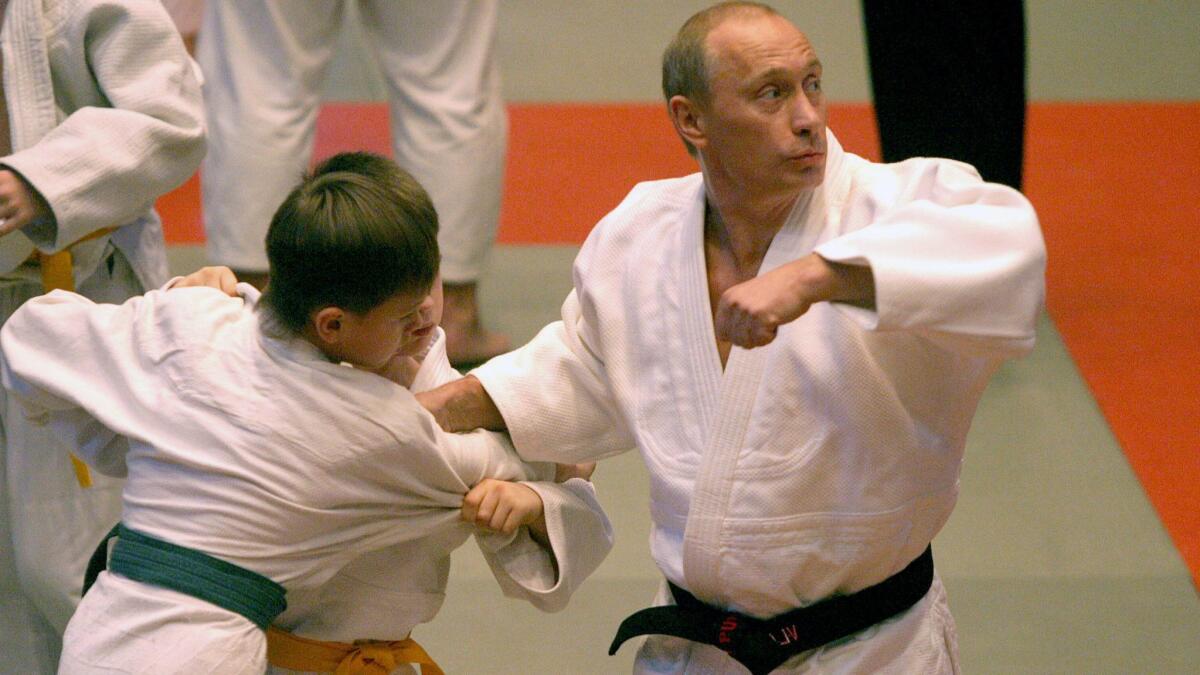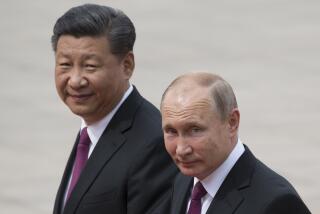Op-Ed: There’s a bigger Russian threat than meddling. Vladimir Putin is acting like he wants war

Russia’s meddling in the 2016 U.S. presidential election was an attack on our sovereignty and can’t be ignored. But we shouldn’t allow it to distract us from the larger threat Russian President Vladimir Putin poses to both the United States and the world.
To understand that threat, we have to examine Putin’s motivations. His policies are dictated by deeply held convictions and ambitions rooted less in Russian patriotism than in Soviet patriotism. In his mind, the end of the Soviet Union was a profound historical injustice, visited upon his country by plotters from without and traitors from within.
His self-imposed mission is to avenge this “tragic,” man-made disaster by recovering for Russia some of the economic, political and geopolitical assets it lost when the Soviet Union collapsed. For Putin, as his policies have made clear again and again, the most important of these is to reoccupy the Soviet Union’s place as an existential alternative — military and moral— to the United States. In the most popular trope of state propaganda, he is “raising Russia off its knees” to make America pay dearly for the humiliation it dealt the Soviet Union.
Russia’s president is never happier or more animated than when he describes Russia’s nuclear hardware, aimed at the United States.
Whether because of his rough childhood in the slums of postwar Leningrad or his training in judo, Putin regards direct confrontation as the ultimate measure of manliness. He views victories in such bouts as proof of superior virtue — for men as well as nations.
For Putin, Russia’s greatest geopolitical success in recent years was the occupation and annexation of Crimea. And the operation’s success, he emphasized, was largely because of his hands-on approach. “Do you know what our advantage was?” he said during an interview. “The fact that I personally dealt with [the operation]!”
Putin’s aggression in Crimea paid off handsomely politically: His support among Russians skyrocketed from a record low of 61% at the end of 2013 to a record high of 86% in October 2014.
Russia is in “total confrontation” mode with the U.S., Putin’s chief of general staff, Valery Gerasimov, declared last year. Putin’s policies match this assessment.
Russia’s president is never happier or more animated than when he describes Russia’s nuclear hardware, aimed at the United States — and invulnerable to U.S. missile defense, as he emphasizes again and again. No Soviet leader ever bragged of his country’s nuclear might the way Putin does. In his two most recent annual state-of-Russia annual addresses to the Federal Assembly, he concluded with triumphant tributes to Russia’s nuclear arsenal, modernized under his loving care and home to the world’s heaviest, fastest and longest-range missiles. He has also touted a new cache of futuristic weapons: underwater nuclear drones, a hypersonic “meteorite;” a mighty ognennyi shar, or “ball of fire,” which Russian wits have called the “flying Chernobyl.” Putin has authorized two multiyear “state armament programs,” costing around a trillion dollars. (Russia’s GDP last year was $1.6 trillion.)
The biggest threat posed by Putin’s militarism, however, is to his nearest neighbors. He has resurrected the Western Military District, established in the Soviet era and abolished by Boris Yeltsin, making it the largest and best armed of Russia’s military districts. NATO members Latvia and Estonia today face between 350,000 and 400,000 troops just across the border in Russia, a tank army, more than 100 fighter jets, four squadrons of long-range bombers, and Russia’s most modern surface-to-air missiles. And they are worried about a Crimea-style annexation of parts of their territories.
Praising the Soviet Union for the way it nurtured patriotism in the young, Putin has created programs that mimic those of the former Soviet Main Political Directorate of the Armed Forces, which had responsibility for propaganda and ideological control. As of last year, 380,000 children under the draft age of 18 were reportedly enrolled in the Yunarmiya (Young Army), created in 2016 to “instill patriotism” and “positive motivation toward military service.” Yunarmiya members enjoy preferential treatment in college admissions and their numbers are expected to swell to 1 million in time for the 75th anniversary of the Victory in the Great Patriotic War (better known as World War II) next spring.
Enter the Fray: First takes on the news of the minute »
The timing of Putin’s war preparations could hardly be worse. Economic growth is projected to be anemic for years to come, personal incomes are down for a fifth consecutive year, and 68% of Russians believe that their country is in an economic crisis. According to a recent survey by the Russian State Statistical Agency, 80% of Russian families have a monthly income that leaves them unable to buy a “minimal assortment” of goods. Thirty-five percent cannot afford to buy two pairs of shoes for each family member.
Putin’s approval ratings have fallen to 64%, only a few percentage points higher than they were before he embarked on his Crimean conquest. While that may sound high to those living in a democracy, it is a troubling number for a politician who operates unchallenged within his country.
The Russian constitution bars Putin from running again in 2024. But if Putin, who clearly would like to rule Russia for life, wants support from Russians in doing so, he will need to boost his popularity before then.
How? Putin has recast himself as a wartime president defending the motherland, and he is determined to restore his country to a victorious superpower status. What better way to accomplish all his goals than to fight and win another military conflict.
Leon Aron is a resident scholar and director of Russian Studies at the American Enterprise Institute.
More to Read
A cure for the common opinion
Get thought-provoking perspectives with our weekly newsletter.
You may occasionally receive promotional content from the Los Angeles Times.










